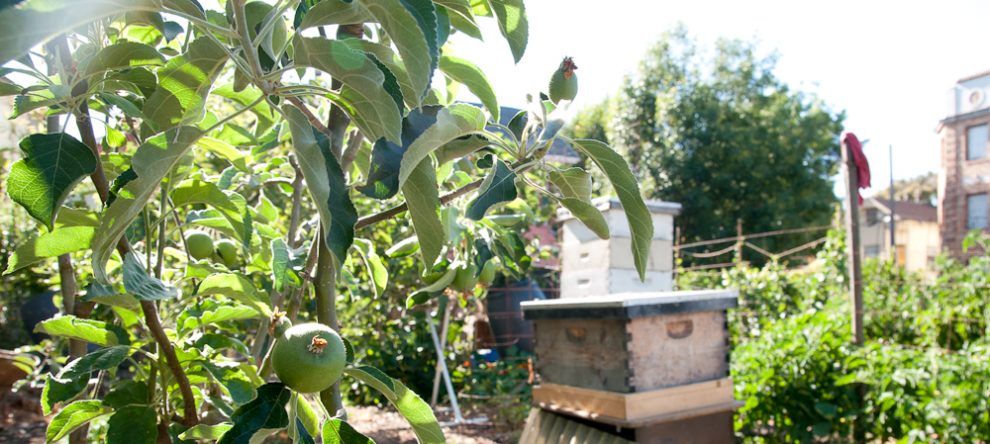In 2005 I killed my first Thanksgiving turkey.
Since then I’ve killed quite a few more, written articles about it, even took part in a turkey harvesting photo shoot (I’ll never do that again, though I loved the photographer, when he asked me to step to the left just before I cut the turkey’s throat, I realized art and practice sometimes shouldn’t meet…) My experience raising a turkey takes up a whole section of my memoir about urban farming. Turkeys–because they are part of Thanksgiving and our American heritage– make great metaphors.
This year was very special in that I got to share the knowledge I’ve accumulated over the last three years with some students. Did you know there’s an urban agriculture class at Berkeley? Lucky undergrads get to grow their own vegetables, learn about international urban ag, and visit local farms. I gave a lecture/presentation to the class one day and then had them come out for visits over the past two weekends.
The first weekend, my friend J graciously offered us three roosters. The neighbors had complained and she called me out of desperation: “can you kill these roosters?” she asked. I walked her through how to do it herself. She listened patiently and then asked again: “can you kill them?” I forget how hard it is the first time.
So she brought the handsome fellows over and the class, with my help, dispatched them. We used the loper method, which I think is fast and humane. Of course we burned a little incense and said our thanks to the birds. The students were great. None of them had ever killed an animal before (on purpose at least) but most of them ate meat and so they wanted to face it. One of the most curious and best entrail cleaner was a vegan! He wants to become a veterianarian, so this was like a lab for him. Awesome. While I showed the students how to kill, pluck, and clean a rooster, I thought of all the people before me who shared this knowledge with me. It felt great to share in an experience I find very anxiety-producing yet full of life and love at the same time.
J took one plucked and cleaned rooster home and gave me the other two. I braised mine. Delicious in a rooster pot pie made with a wee bit of leftover lard in the pie crusts.
The next weekend, just yesterday in fact, it was time to say goodbye to Archie 2 and Edith. The class came out again (different students this time) to assist. Killing a turkey is a bigger deal than the roosters. They’re big. They’re full of life-force. Their feathers are so large, their bodies are so warm. The males have some special parts like the beard and the snood which add some level of mystery to the birds. I hadn’t realized how fat Archie #2 had gotten. He must have weighed 25 pounds! Edith was much smaller, only a bit bigger than the roosters from the previous weekend.
The students gathered in the garden. I had set up workstations: the plucking table, the cleaning table, the dipping area. We stood near the killing area, which featured a pair of enormous lopers, incense, and a bucket. I retrieved Edith from the backyard first. We burned incense and I described her life, which was going on two years. She never did hatch out any baby turkey poults, and for that I was sad. But she had a good run, enjoyed bossing the chickens and Archie around. But now it was time for her to go. I gave her a kiss, then a student loped her head off. It’s nice to have someone around who didn’t *know* the turkey. We plucked her and cleaned her entrails. Her gizzard was happy and full of rocks and grains. She ate well, that’s for sure.
Next came Archie#2. Enormous. My arms ached carrying him from the backyard to the front. We usually have heritage breeds but Archie looked to be just a Standard White. He had grown so so fast. After some kind words (but not too many, he was heavy!) the Berkeley instructor held the turkey’s feet, I hugged the turkey’s wings, and a student loped the head off. As the life-force drained out of the turkey, I accidentally let go of his wings which caused (I later found out) a horrible jolt to the groin of the instructor. Oops! It’s dangerous out here on GhostTown Farm, I reckon. Sorry N! The plucking and cleaning proceeded as normal. Archie had a gizzard the size of a softball and a crop the size of a football. No wonder the chickens are always hungry competing with that guy!
The students lingered in the garden after all was said and done. It was a sunny late November day. The bees were out, the greens were so bright. It was hard to tear ourselves away from the moment, when things felt so real. I felt a little proud that I could show someone something I knew how to do. That finally, I have some knowledge that can be passed on, remembered, used, and hear stories about where that knowldege led other people once they knew too.
I brined Archie and Edith. I think I’m going to deep-fry Archie. Edith, as her age dictates, will be braised.
Late afternoon addition: Can’t find anyone to deep fry the turkey. So I’m turning to Chef Edwards and he will be smoking the turkeys all day long tomorrow!










